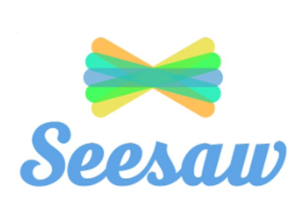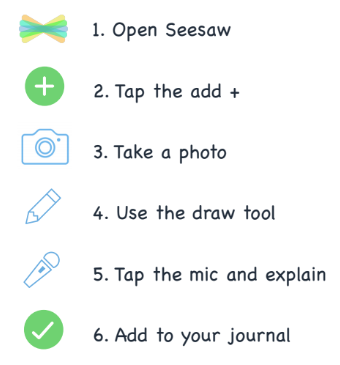
Picturing Addition with SeeSaw

Overview
Seesaw is a web-based and application platform where students can post pictures from the classroom, annotate, speak their mind, and create electronic portfolios that connect school and home. Parents are able to see student work as soon as it is posted.
In this activity, students will solve a math problem and explain their thinking using SeeSaw.
Learning Objectives
Students will:
- Be able to explain their thought process of solving.
- Be able to represent an addition problem and post their explanation to SeeSaw.
Vocabulary
Vocabulary Words:
-
Draw Tool: A draw tool is a tool that you choose on the computer to draw using a spray can, pen, pencil, or any other paint tool.
-
Journal: A journal in SeeSaw allows students to show what they have learned. (photos, videos, drawings, text)
Pre-planning
To prepare for this lesson:
-
Before the lesson, teachers must set up SeeSaw accounts for their class and invite parents to join.
-
Please view the TEACHER video on using SeeSaw in the classroom.
-
-
Students should also know the basic features of SeeSaw.
-
Please view the following videos to decide how your students will access SeeSaw. Students can access it with email, a class code or a QR code.
-
-
Here is a student video on how to use SeeSaw.
-
The SeeSaw app needs to be downloaded on student devices or bookmarked on computers.
-
Teachers will need to have counting manipulatives available to students.
Note: SeeSaw has many other tutorials on their website and Help Center.
Accommodations
See the Accommodations Page and Charts on the 21things4students website in the Teacher Resources.
Steps
Directions for this activity:
1. Students will first be taught how to add objects together in a whole group lesson. The teacher will display four of one manipulative, and three of another. (e.g., four red counting bears and three yellow counting bears).

2. The teacher points to each red bear and counts 1, 2, 3, 4. Then writes that number down. The teacher then counts the yellow bears in the same fashion, writing the number down to form a math sentence.
3. The teacher then groups all the bears together and counts them with the class. After counting, the teacher writes down that number to complete the number sentence.

4. The teacher repeats this process with different numbers of bears until they observe almost all kids participating in counting and adding the manipulatives together. Students will be asked to do the same thing during independent work.
5. Independent Work: Students take what they have learned about adding and use manipulatives to demonstrate addition. Students will practice counting the separate groups and then counting both groups together.
6. Once they have practiced grouping and counting their manipulative, they will add their learning to SeeSaw.
7. Students open the SeeSaw app and press the “+” sign, then select the camera icon to take a photo of their addition problem. They may take a picture of the two groups of manipulatives before adding.
8. Next, students select the draw tool to label their addition problem as the teacher did in the group demonstration.
9. After labeling their patterns, students tap the microphone and record themselves counting the manipulatives to show how they got their answer.
10. When finished, students select the green check to add it to their journal.
Here is a photo of the steps to add and explain a photo in SeeSaw:

Assessment Options
Different options for assessing the students:
- Observations
- Check for understanding
- Teachers can see what students have posted to their journal from the Teacher side of SeeSaw. They are able to leave feedback for students and intervene with any students who does not get the addition concept.
MITECS Competencies & ISTE Standards
MITECS: Michigan adopted the "ISTE Standards for Students" called MITECS (Michigan Integrated Technology Competencies for Students) in 2018.
Computational Thinker
5c. Students break problems into component parts, extract key information, and develop descriptive models to understand complex systems or facilitate problem-solving.
Devices and Resources
SeeSaw works on all devices, but works best on devices with a camera and microphone.
Websites:
Get Students Started on Seesaw: Sign in with a code
Get Students Started on Seesaw: Sign in with email
CONTENT AREA RESOURCES
Math
Students use 1:1 counting to solve basic addition problems. Students explain their thinking using the SeeSaw app. Teachers are able to see if students are able to count 1:1 and if they understand how to add objects together.
CREDITS
This task card was created by Lacey Khohn, KRESA, November 2018. Updated October 2023.


